Taylor D.A. Introduction to marine engineering
Подождите немного. Документ загружается.

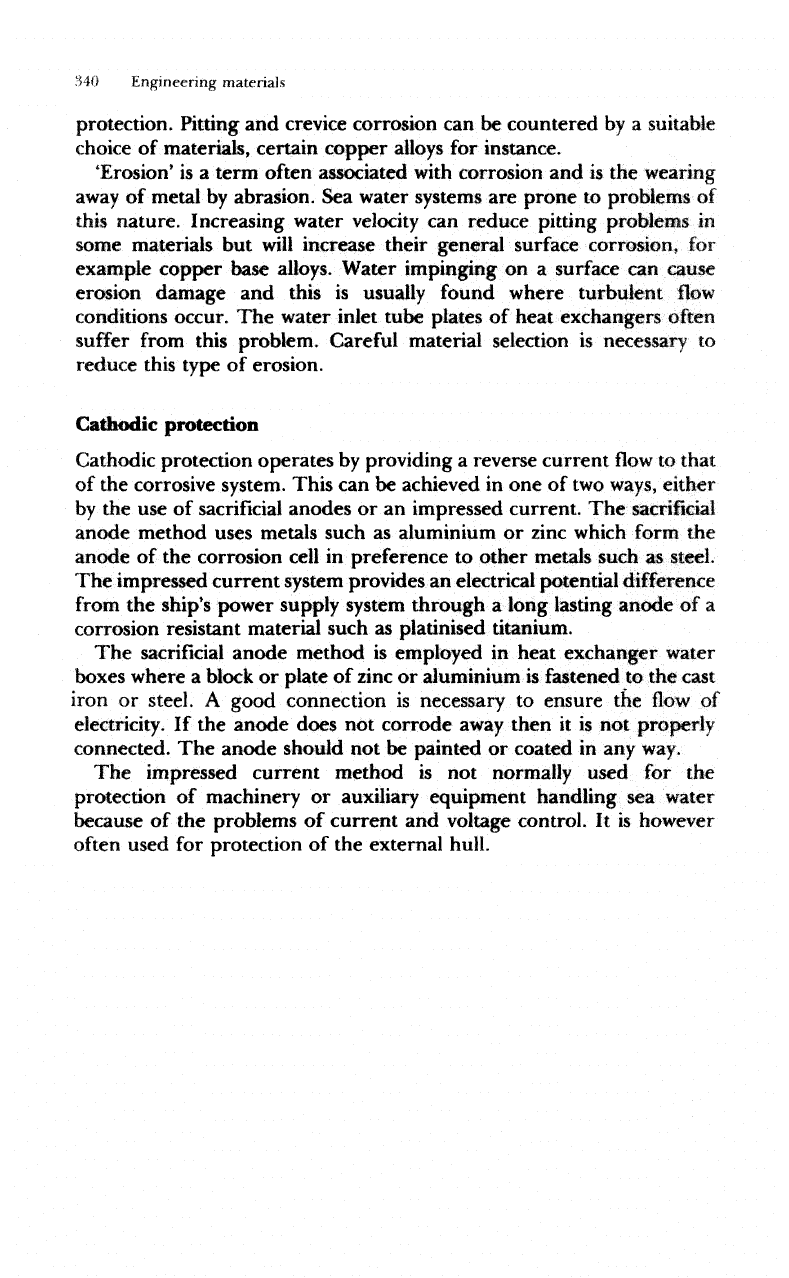
340
Engineering
materials
protection. Pitting
and
crevice
corrosion
can be
countered
by a
suitable
choice
of
materials, certain
copper
alloys
for
instance.
'Erosion'
is a
term often associated
with
corrosion
and is the
wearing
away
of
metal
by
abrasion.
Sea
water systems
are
prone
to
problems
of
this
nature. Increasing water
velocity
can
reduce pitting
problems
in
some materials
but
will
increase their general
•
surface
corrosion,.
for
example
copper
base alloys. Water impinging
on a
surface
can
cause
erosion damage
and
this
is
usually found where turbulent
flow
conditions occur.
The
water inlet tube plates
of
heat
exchangers'
often
suffer
from this problem. Careful material selection
is
necessary
to
reduce this type
of
erosion.
Cathodic
protection
Cathodic protection operates
by
providing
a
reverse current
flow to
that
of
the
corrosive system. This
can be
achieved
in one of two
ways,
either
by
the use of
sacrificial
anodes
or an
impressed current.
The
sacrificial
anode method uses metals such
as
aluminium
or
zinc
which
form
the
anode
of the
corrosion cell
in
preference
to
other
metals such
as
steel.
The
impressed current system provides
an
electrical
potential difference
from
the
ship's
power supply system through
a
long lasting
anode
of a
corrosion resistant material such
as
platinised titanium.
The
sacrificial anode method
is
employed
in
heat exchanger water
boxes where
a
block
or
plate
of
zinc
or
aluminium
is
fastened
to the
cast
iron
or
steel.
A
good connection
is
necessary
to
ensure
the flow of
electricity.
If the
anode does
not
corrode
away
then
it is not
properly
connected.
The
anode
should
not be
painted
or
coated
in any
way.
The
impressed current method
is
not
normally used
for the
protection
of
machinery
or
auxiliary equipment handling
sea
water
because
of the
problems
of
current
and
voltage control.
It is
however
often
used
for
protection
of the
external
hull.
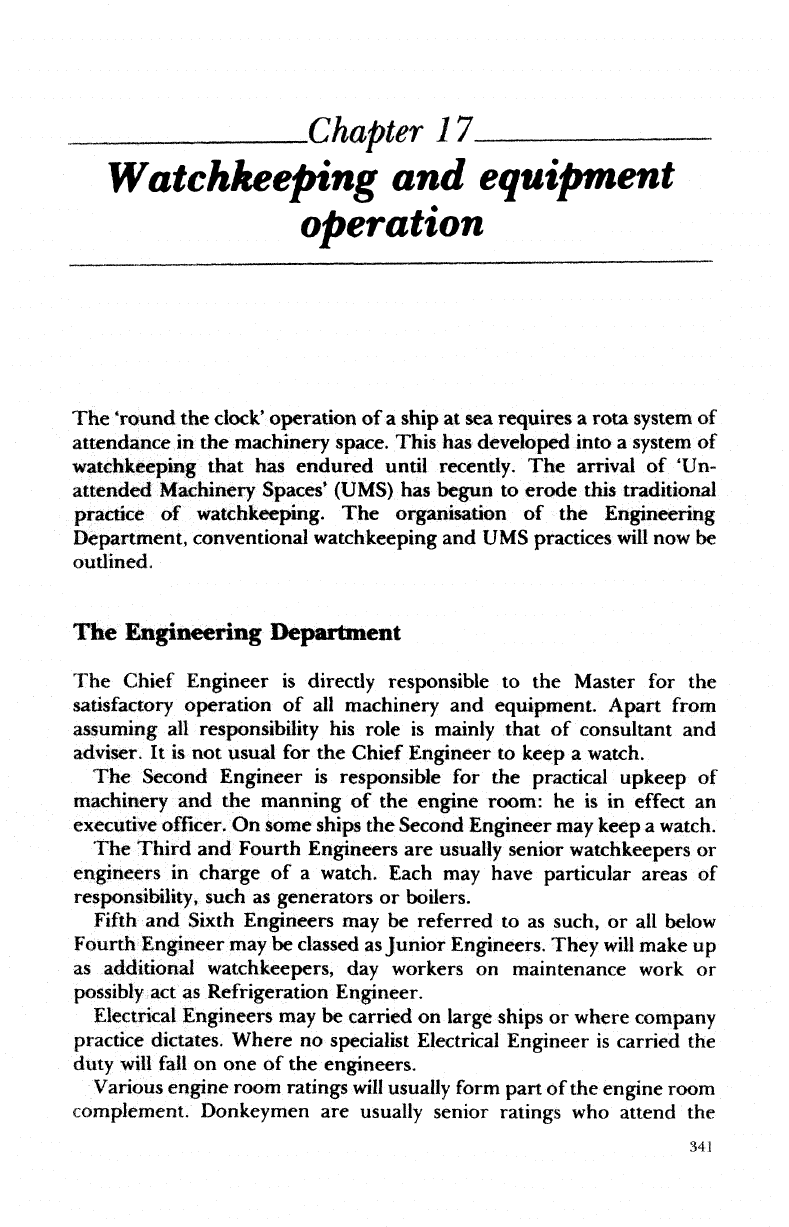
The
Vound
the
clock'
operation
of a
ship
at sea
requires
a
rota
system
of
attendance
in the
machinery space. This
has
developed
into
a
system
of
watchkeeping
that
has
endured
until recently.
The
arrival
of
'Un-
attended
Machinery
Spaces'
(UMS)
has
begun
to
erode
this traditional
practice
of
watchkeeping.
The
organisation
of the
Engineering
Department, conventional watchkeeping
and UMS
practices
will
now be
outlined.
The
Engineering
Department
The
Chief Engineer
is
directly responsible
to the
Master
for the
satisfactory
operation
of all
machinery
and
equipment. Apart
from
assuming
all
responsibility
his
role
is
mainly
that
of
consultant
and
adviser.
It is not
usual
for the
Chief Engineer
to
keep
a
watch.
The
Second Engineer
is
responsible
for the
practical upkeep
of
machinery
and the
manning
of the
engine room:
he is in
effect
an
executive
officer.
On
some ships
the
Second Engineer
may
keep
a
watch.
The
Third
and
Fourth Engineers
are
usually
senior
watchkeepers
or
engineers
in
charge
of a
watch. Each
may
have particular areas
of
responsibility,
such
as
generators
or
boilers.
Fifth
and
Sixth Engineers
may be
referred
to as
such,
or all
below
Fourth Engineer
may be
classed
as
Junior Engineers. They
will
make
up
as
additional watchkeepers,
day
workers
on
maintenance
work
or
possibly
act as
Refrigeration Engineer.
Electrical
Engineers
may be
carried
on
large ships
or
where company
practice
dictates. Where
no
specialist Electrical Engineer
is
carried
the
duty
will
fall
on one of the
engineers.
Various
engine room ratings
will
usually
form
part
of the
engine room
complement.
Donkeymen
are
usually
senior ratings
who
attend
the
341
Chapter
17
Watchkeeping
and
equipment
operation
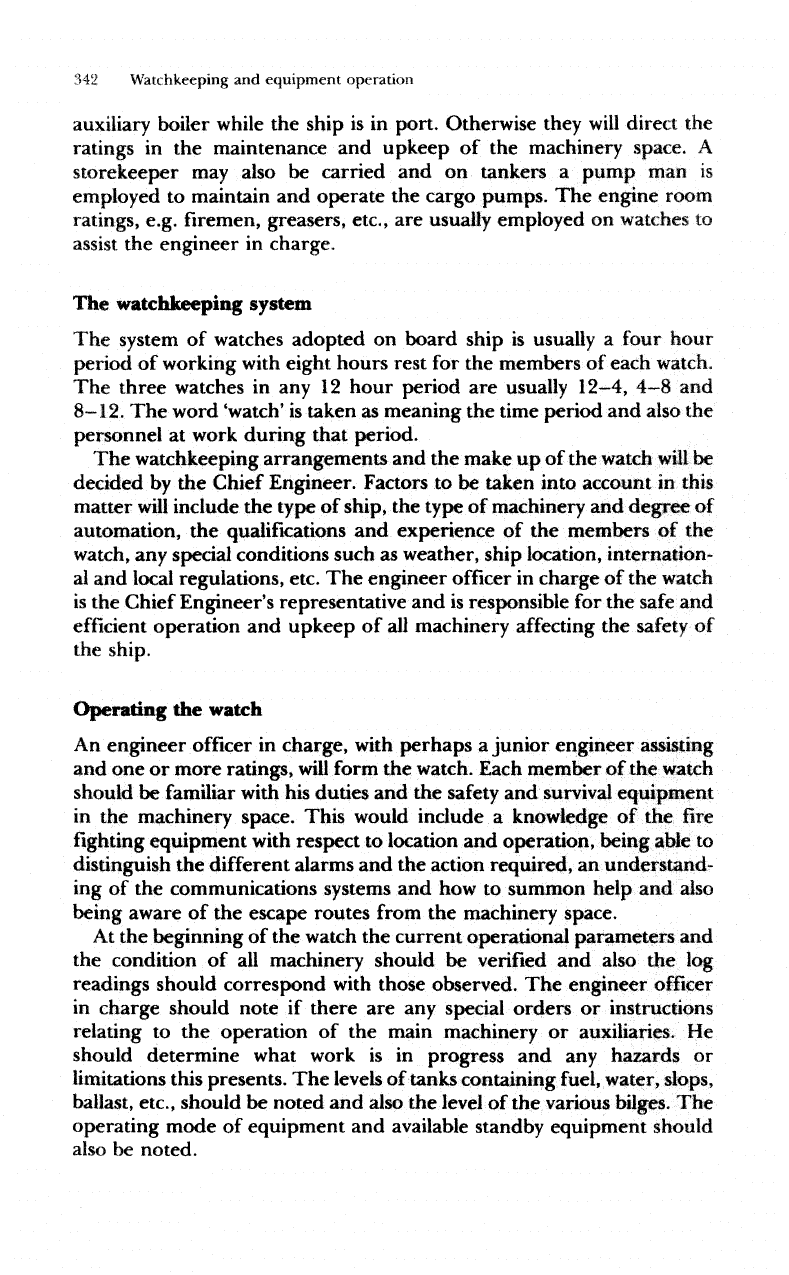
342
Watchkeeping
and
equipment operation
auxiliary
boiler
while
the
ship
is in
port.
Otherwise they
will
direct
the
ratings
in the
maintenance
and
upkeep
of the
machinery space.
A
storekeeper
may
also
be
carried
and
on
tankers
a
pump
man is
employed
to
maintain
and
operate
the
cargo pumps.
The
engine room
ratings,
e.g.
firemen,
greasers, etc.,
are
usually
employed
on
watches
to
assist
the
engineer
in
charge.
The
watchkeeping
system
The
system
of
watches adopted
on
board ship
is
usually
a
four
hour
period
of
working
with
eight hours rest
for the
members
of
each
watch.
The
three
watches
in any 12
hour period
are
usually
12-4,
4—8
and
8-12.
The
word
'watch'
is
taken
as
meaning
the
time
period
and
also
the
personnel
at
work
during that
period.
The
watchkeeping arrangements
and the
make
up of the
watch
will
be
decided
by the
Chief Engineer. Factors
to be
taken into account
in
this
matter
will
include
the
type
of
ship,
the
type
of
machinery
and
degree
of
automation,
the
qualifications
and
experience
of the
members
of the
watch,
any
special conditions such
as
weather, ship location, internation-
al
and
local regulations, etc.
The
engineer
officer
in
charge
of the
watch
is
the
Chief Engineer's representative
and is
responsible
for the
safe
and
efficient
operation
and
upkeep
of all
machinery
affecting
the
safety
of
the
ship.
Operating
the
watch
An
engineer
officer
in
charge,
with
perhaps
a
junior engineer assisting
and one or
more ratings,
will
form
the
watch. Each member
of the
watch
should
be
familiar with
his
duties
and the
safety
and
survival
equipment
in
the
machinery space.
This
would include
a
knowledge
of
the
fire
fighting
equipment with
respect
to
location
and
operation,
being able
to
distinguish
the
different alarms
and the
action
required,
an
understand-
ing
of the
communications systems
and how to
summon help
and
also
being aware
of the
escape routes
from
the
machinery space.
At
the
beginning
of the
watch
the
current operational parameters
and
the
condition
of all
machinery should
be
verified
and
also
the log
readings should correspond
with
those observed.
The
engineer
officer
in
charge should note
if
there
are any
special
orders
or
instructions
relating
to the
operation
of the
main machinery
or
auxiliaries.
He
should determine
what
work
is in
progress
and any
hazards
or
limitations
this presents.
The
levels
of
tanks containing
fuel,
water, slops,
ballast,
etc., should
be
noted
and
also
the
level
of the
various bilges.
The
operating mode
of
equipment
and
available standby equipment should
also
be
noted.
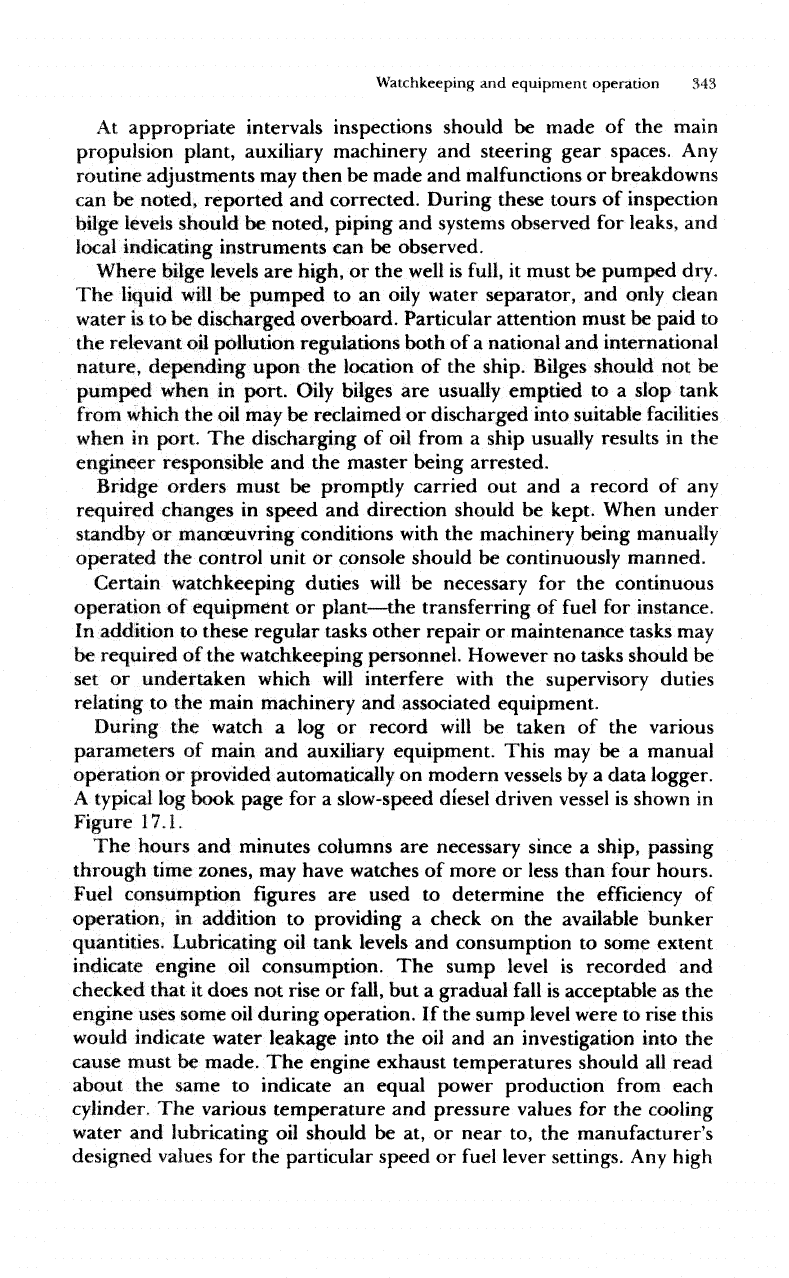
Watchkeeping
and
equipment
operation
343
At
appropriate intervals inspections should
be
made
of the
main
propulsion plant, auxiliary machinery
and
steering
gear
spaces.
Any
routine adjustments
may
then
be
made
and
malfunctions
or
breakdowns
can
be
noted,
reported
and
corrected.
During
these
tours
of
inspection
bilge levels should
be
noted,
piping
and
systems
observed
for
leaks,
and
local
indicating instruments
can be
observed.
Where bilge levels
are
high,
or the
well
is
full,
it
must
be
pumped dry.
The
liquid
will
be
pumped
to an
oily
water
separator,
and
only clean
water
is to be
discharged
overboard.
Particular attention must
be
paid
to
the
relevant
oil
pollution regulations both
of a
national
and
international
nature,
depending
upon
the
location
of the
ship. Bilges should
not be
pumped
when
in
port.
Oily bilges
are
usually emptied
to a
slop
tank
from
which
the oil may be
reclaimed
or
discharged into suitable
facilities
when
in
port.
The
discharging
of oil
from
a
ship usually results
in the
engineer
responsible
and the
master being
arrested.
Bridge
orders
must
be
promptly carried
out and a
record
of
any
required
changes
in
speed
and
direction should
be
kept. When under
standby
or
manceuvring
conditions
with
the
machinery being
manually
operated
the
control unit
or
console should
be
continuously manned.
Certain watchkeeping duties
will
be
necessary
for the
continuous
operation
of
equipment
or
plant—the
transferring
of
fuel
for
instance.
In
addition
to
these regular tasks
other
repair
or
maintenance tasks
may
be
required
of the
watchkeeping personnel. However
no
tasks should
be
set or
undertaken
which
will
interfere
with
the
supervisory duties
relating
to the
main machinery
and
associated equipment.
During
the
watch
a log or
record
will
be
taken
of the
various
parameters
of
main
and
auxiliary equipment. This
may be a
manual
operation
or
provided automatically
on
modern vessels
by a
data
logger.
A
typical
log
book page
for a
slow-speed diesel driven vessel
is
shown
in
Figure
17.1.
The
hours
and
minutes columns
are
necessary since
a
ship,
passing
through time zones,
may
have watches
of
more
or
less than four hours.
Fuel consumption figures
are
used
to
determine
the
efficiency
of
operation,
in
addition
to
providing
a
check
on the
available bunker
quantities. Lubricating
oil
tank levels
and
consumption
to
some extent
indicate engine
oil
consumption.
The
sump level
is
recorded
and
checked that
it
does
not
rise
or
fall,
but a
gradual
fall
is
acceptable
as the
engine uses some
oil
during
operation.
If the
sump level were
to
rise this
would
indicate water leakage into
the
oil
and an
investigation into
the
cause
must
be
made.
The
engine exhaust temperatures should
ail
read
about
the
same
to
indicate
an
equal power production from each
cylinder.
The
various temperature
and
pressure values
for the
cooling
water
and
lubricating
oil
should
be at, or
near
to, the
manufacturer's
designed values
for the
particular speed
or
fuel
lever settings.
Any
high
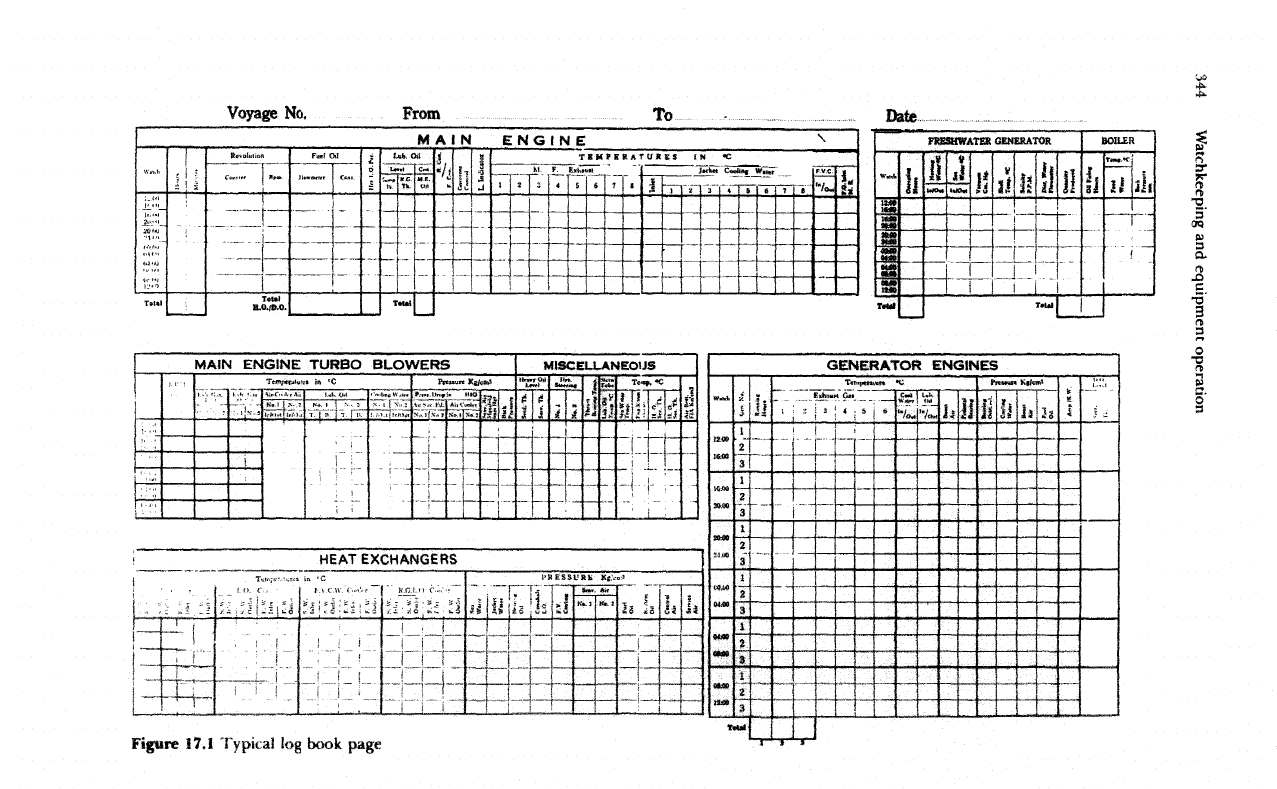
344
Watchkeeping
and
equipment operation
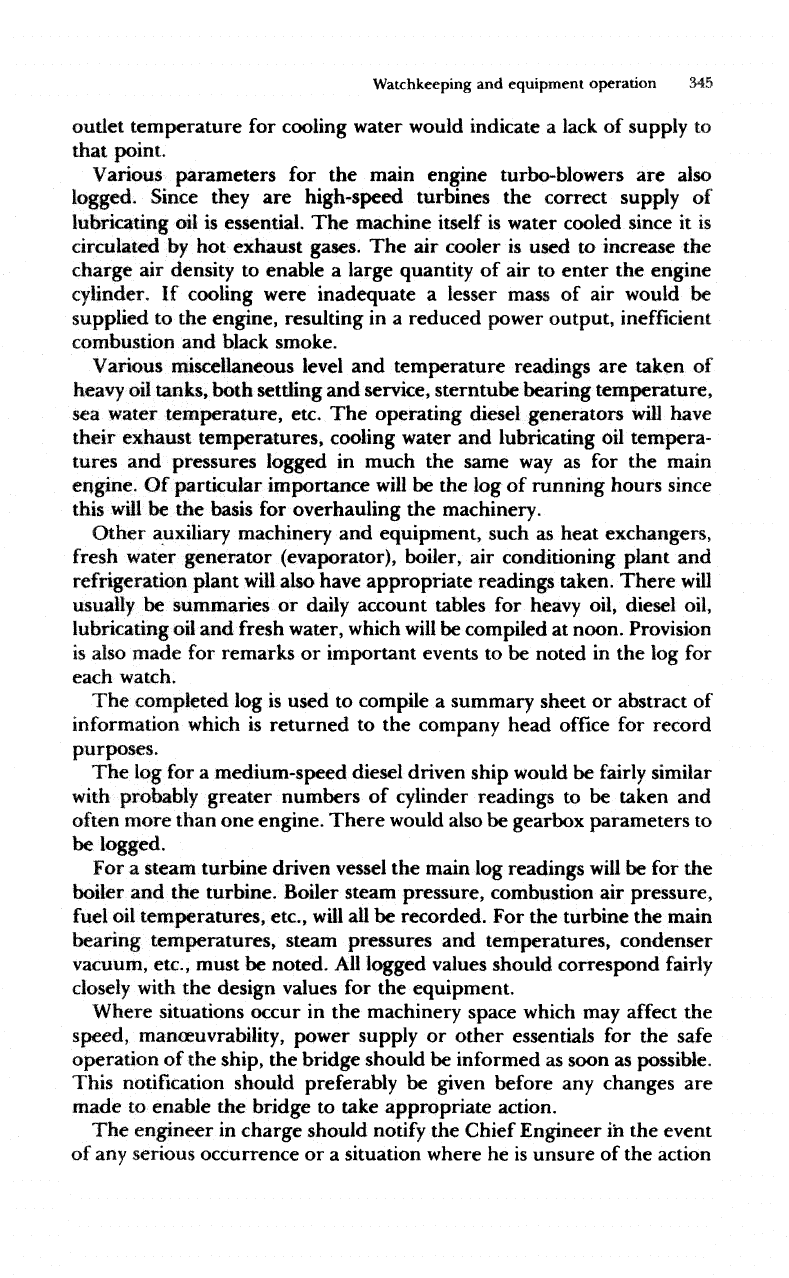
Watchkeeping
and
equipment operation
345
outlet temperature
for
cooling water would indicate
a
lack
of
supply
to
that
point.
Various
parameters
for the
main engine
turbo-blowers
are
also
logged. Since they
are
high-speed turbines
the
correct supply
of
lubricating
oil is
essential.
The
machine itself
is
water cooled since
it is
circulated
by hot
exhaust
gases.
The air
cooler
is
used
to
increase
the
charge
air
density
to
enable
a
large quantity
of air to
enter
the
engine
cylinder.
If
cooling were inadequate
a
lesser mass
of air
would
be
supplied
to the
engine, resulting
in a
reduced power output,
inefficient
combustion
and
black smoke.
Various
miscellaneous level
and
temperature readings
are
taken
of
heavy
oil
tanks, both settling
and
service,
sterntube
bearing temperature,
sea
water temperature, etc.
The
operating diesel generators
will
have
their
exhaust temperatures, cooling water
and
lubricating
oil
tempera-
tures
and
pressures logged
in
much
the
same
way as for the
main
engine.
Of
particular importance
will
be the log of
running hours since
this
will
be the
basis
for
overhauling
the
machinery.
Other
auxiliary
machinery
and
equipment, such
as
heat exchangers,
fresh
water generator (evaporator), boiler,
air
conditioning plant
and
refrigeration
plant
will
also have
appropriate
readings taken.
There
will
usually
be
summaries
or
daily account tables
for
heavy
oil, diesel oil,
lubricating
oil and
fresh
water,
which
will
be
compiled
at
noon. Provision
is
also made
for
remarks
or
important events
to be
noted
in the log for
each
watch.
The
completed
log is
used
to
compile
a
summary sheet
or
abstract
of
information
which
is
returned
to the
company head
office
for
record
purposes.
The log for a
medium-speed
diesel driven ship would
be
fairly
similar
with
probably
greater
numbers
of
cylinder readings
to be
taken
and
often
more than
one
engine.
There
would also
be
gearbox parameters
to
be
logged.
For a
steam turbine driven vessel
the
main
log
readings
will
be for the
boiler
and the
turbine. Boiler steam
pressure,
combustion
air
pressure,
fuel
oil
temperatures, etc.,
will
all be
recorded.
For the
turbine
the
main
bearing
temperatures,
steam pressures
and
temperatures, condenser
vacuum,
etc., must
be
noted.
All
logged values should correspond
fairly
closely
with
the
design
values
for the
equipment.
Where
situations occur
in the
machinery space
which
may
affect
the
speed,
manoeuvrability,
power supply
or
other essentials
for the
safe
operation
of the
ship,
the
bridge
should
be
informed
as
soon
as
possible.
This
notification
should preferably
be
given
before
any
changes
are
made
to
enable
the
bridge
to
take appropriate action.
The
engineer
in
charge should
notify
the
Chief Engineer
in the
event
of
any
serious occurrence
or a
situation where
he is
unsure
of the
action
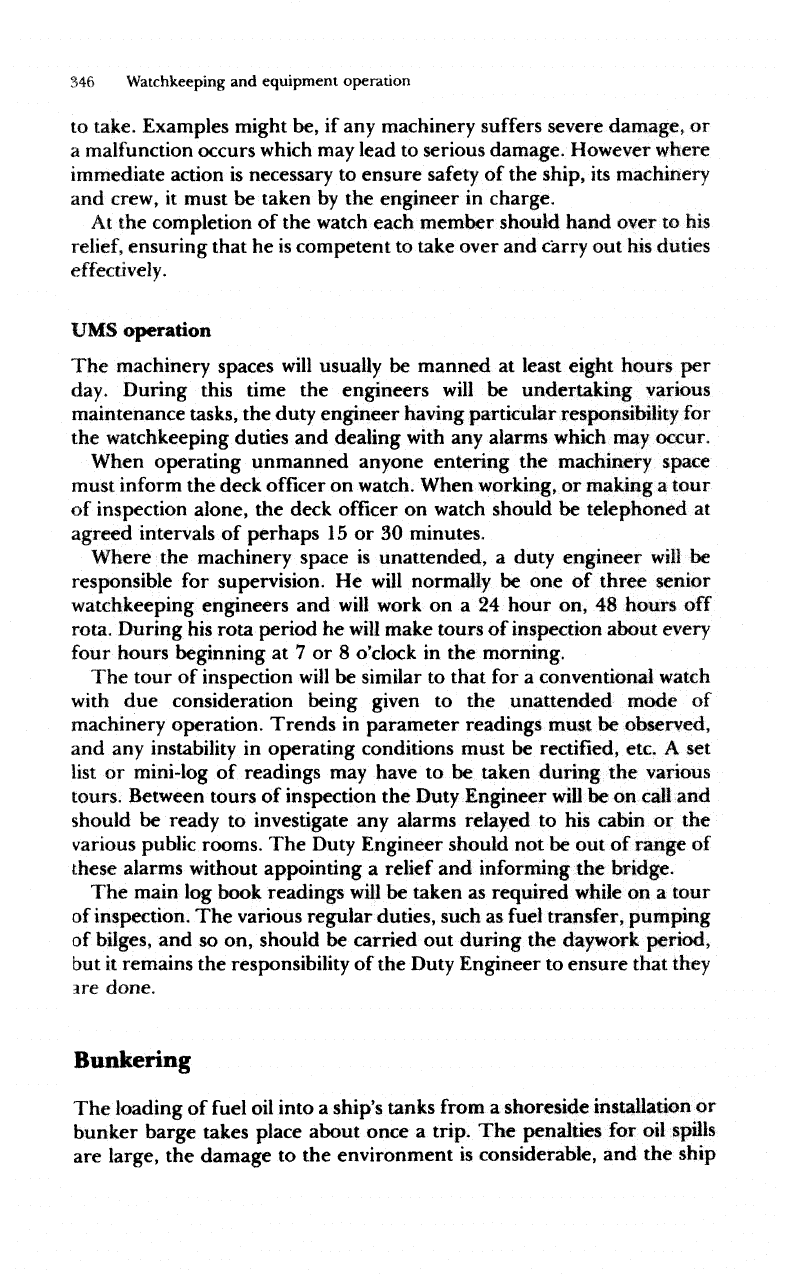
346
Watchkeeping
and
equipment operation
to
take. Examples might
be, if any
machinery
suffers
severe
damage,
or
a
malfunction
occurs
which
may
lead
to
serious damage. However where
immediate action
is
necessary
to
ensure
safety
of the
ship,
its
machinery
and
crew,
it
must
be
taken
by the
engineer
in
charge.
At
the
completion
of the
watch
each
member should hand over
to his
relief,
ensuring that
he is
competent
to
take over
and
carry
out his
duties
effectively.
UMS
operation
The
machinery spaces
will
usually
be
manned
at
least eight hours
per
day. During this time
the
engineers
will
be
undertaking various
maintenance
tasks,
the
duty
engineer
having particular responsibility
for
the
watchkeeping
duties
and
dealing
with
any
alarms
which
may
occur.
When
operating unmanned anyone
entering
the
machinery space
must
inform
the
deck
officer
on
watch. When
working,
or
making
a
tour
of
inspection alone,
the
deck
officer
on
watch should
be
telephoned
at
agreed intervals
of
perhaps
15
or 30
minutes.
Where
the
machinery space
is
unattended,
a
duty engineer
will
be
responsible
for
supervision.
He
will
normally
be one of
three senior
watchkeeping
engineers
and
will
work
on a 24
hour
on, 48
hours
off
rota.
During
his
rota
period
he
will
make
tours
of
inspection
about
every
four
hours beginning
at 7 or 8
o'clock
in the
morning.
The
tour
of
inspection
will
be
similar
to
that
for a
conventional
watch
with
due
consideration being given
to the
unattended mode
of
machinery
operation.
Trends
in
parameter readings must
be
observed,
and
any
instability
in
operating conditions must
be
rectified, etc.
A
set
list
or
mini-log
of
readings
may
have
to be
taken during
the
various
tours. Between tours
of
inspection
the
Duty Engineer
will
be
on
call
and
should
be
ready
to
investigate
any
alarms relayed
to his
cabin
or the
various
public rooms.
The
Duty
Engineer should
not be out of
range
of
these alarms without appointing
a
relief
and
informing
the
bridge.
The
main
log
book readings
will
be
taken
as
required
while
on a
tour
of
inspection.
The
various regular duties, such
as
fuel
transfer, pumping
of
bilges,
and so on,
should
be
carried
out
during
the
daywork
period,
but
it
remains
the
responsibility
of the
Duty Engineer
to
ensure that they
are
done.
Bunkering
The
loading
of
fuel
oil
into
a
ship's
tanks from
a
shoreside
installation
or
bunker
barge
takes place about once
a
trip.
The
penalties
for oil
spills
are
large,
the
damage
to the
environment
is
considerable,
and
the
ship
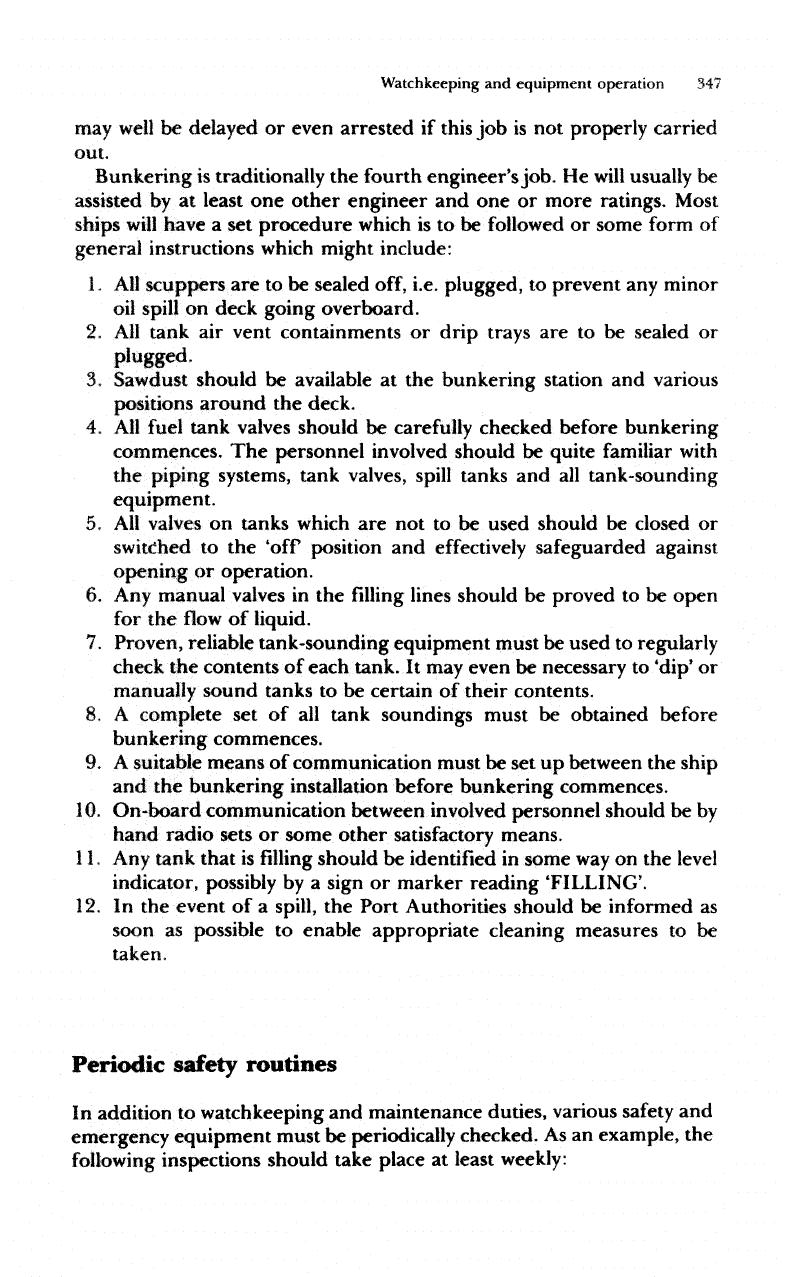
Watchkeeping
and
equipment operation
347
may
well
be
delayed
or
even
arrested
if
this
job is not
properly carried
out.
Bynkering
is
traditionally
the
fourth
engineer's
job.
He
will
usually
be
assisted
by at
least
one
other
engineer
and one or
more ratings. Most
ships
will
have
a set
procedure
which
is to be
followed
or
some
form
of
general instructions
which
might
include:
1.
AH
scuppers
are to be
sealed off, i.e. plugged,
to
prevent
any
minor
oil
spill
on
deck going overboard.
2.
All
tank
air
vent
containments
or
drip trays
are to be
sealed
or
plugged.
3.
Sawdust should
be
available
at the
bunkering station
and
various
positions around
the
deck.
4. All
fuel
tank valves should
be
carefully
checked before bunkering
commences.
The
personnel
involved should
be
quite
familiar
with
the
piping systems, tank
valves,
spill
tanks
and all
tank-sounding
equipment.
5.
All
valves
on
tanks which
are not to be
used should
be
closed
or
switched
to the
'off
position
and
effectively
safeguarded against
opening
or
operation.
6. Any
manual
valves
in the
filling
lines should
be
proved
to be
open
for
the flow of
liquid.
7.
Proven, reliable tank-sounding equipment must
be
used
to
regularly
check
the
contents
of
each tank.
It may
even
be
necessary
to
'dip'
or
manually
sound tanks
to be
certain
of
their contents.
8. A
complete
set of all
tank soundings must
be
obtained before
bunkering commences.
9. A
suitable means
of
communication must
be set up
between
the
ship
and the
bunkering installation before bunkering commences.
10.
On-board
communication between involved personnel should
be by
hand
radio
sets
or
some
other
satisfactory means.
11.
Any
tank that
is filling
should
be
identified
in
some
way on the
level
indicator, possibly
by a
sign
or
marker reading
'FILLING'.
12.
In the
event
of a
spill,
the
Port
Authorities should
be
informed
as
soon
as
possible
to
enable appropriate cleaning measures
to be
taken.
Periodic
safety
routines
In
addition
to
watchkeeping
and
maintenance duties, various
safety
and
emergency equipment must
be
periodically checked.
As an
example,
the
following
inspections should take place
at
least weekly:
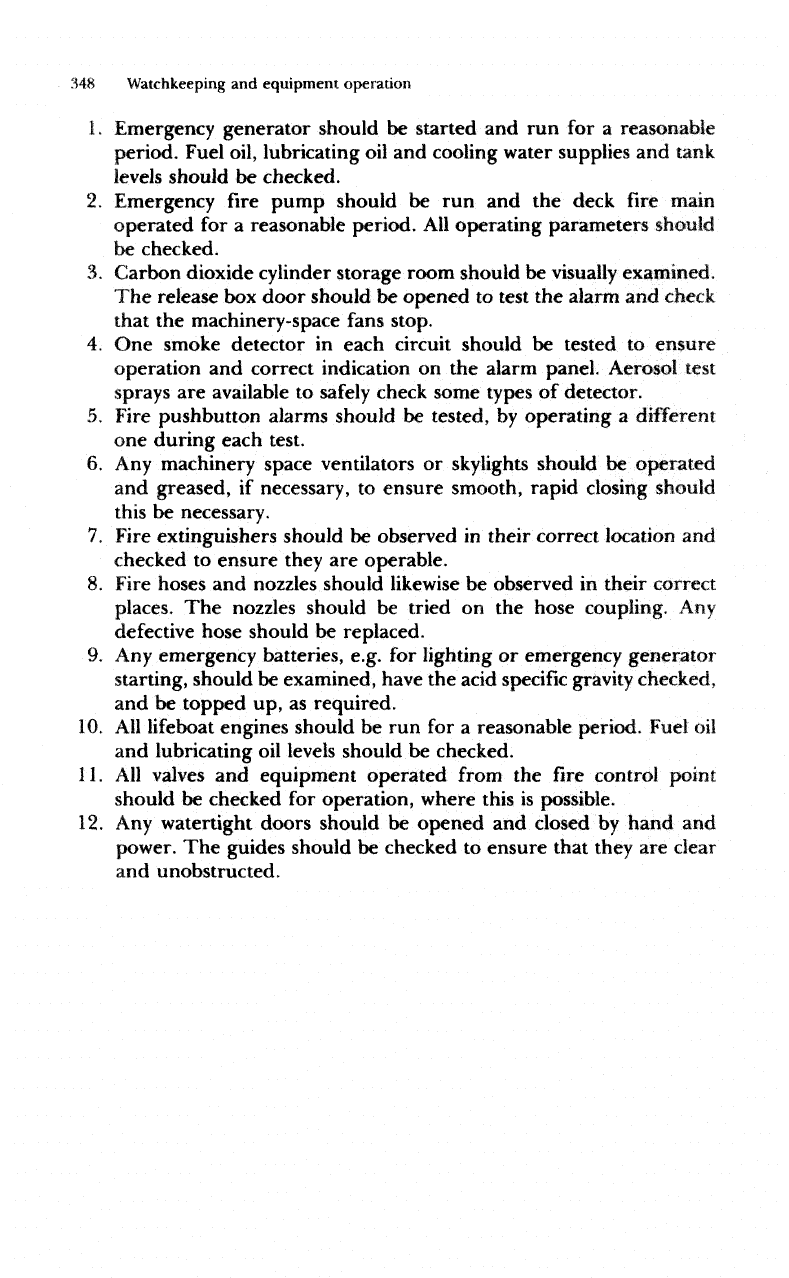
348
Watchkeeping
and
equipment operation
1.
Emergency generator
should
be
started
and run for a
reasonable
period.
Fuel oil, lubricating
oil and
cooling water supplies
and
tank
levels
should
be
checked.
2.
Emergency
fire
pump should
be run and the
deck
fire
main
operated
for a
reasonable period.
AH
operating parameters should
be
checked.
3.
Carbon dioxide cylinder storage room should
be
visually
examined.
The
release
box
door
should
be
opened
to
test
the
alarm
and
check
that
the
machinery-space
fans
stop.
4.
One
smoke detector
in
each circuit should
be
tested
to
ensure
operation
and
correct indication
on the
alarm panel. Aerosol test
sprays
are
available
to
safely
check some types
of
detector.
5.
Fire pushbutton alarms should
be
tested,
by
operating
a
different
one
during each test.
6. Any
machinery space ventilators
or
skylights
should
be
operated
and
greased,
if
necessary,
to
ensure smooth, rapid closing
should
this
be
necessary.
7.
Fire extinguishers should
be
observed
in
their
correct
location
and
checked
to
ensure
they
are
operable.
8.
Fire hoses
and
nozzles
should
likewise
be
observed
in
their correct
places.
The
nozzles
should
be
tried
on the
hose
coupling.
Any
defective
hose should
be
replaced.
9.
Any
emergency batteries, e.g.
for
lighting
or
emergency
generator
starting,
should
be
examined, have
the
acid
specific
gravity
checked,
and
be
topped
up, as
required.
10.
All
lifeboat engines should
be run for a
reasonable
period.
Fuel
oil
and
lubricating
oil
levels
should
be
checked.
11.
All
valves
and
equipment
operated
from
the fire
control point
should
be
checked
for
operation, where this
is
possible.
12.
Any
watertight
doors should
be
opened
and
closed
by
hand
and
power.
The
guides should
be
checked
to
ensure that they
are
clear
and
unobstructed.
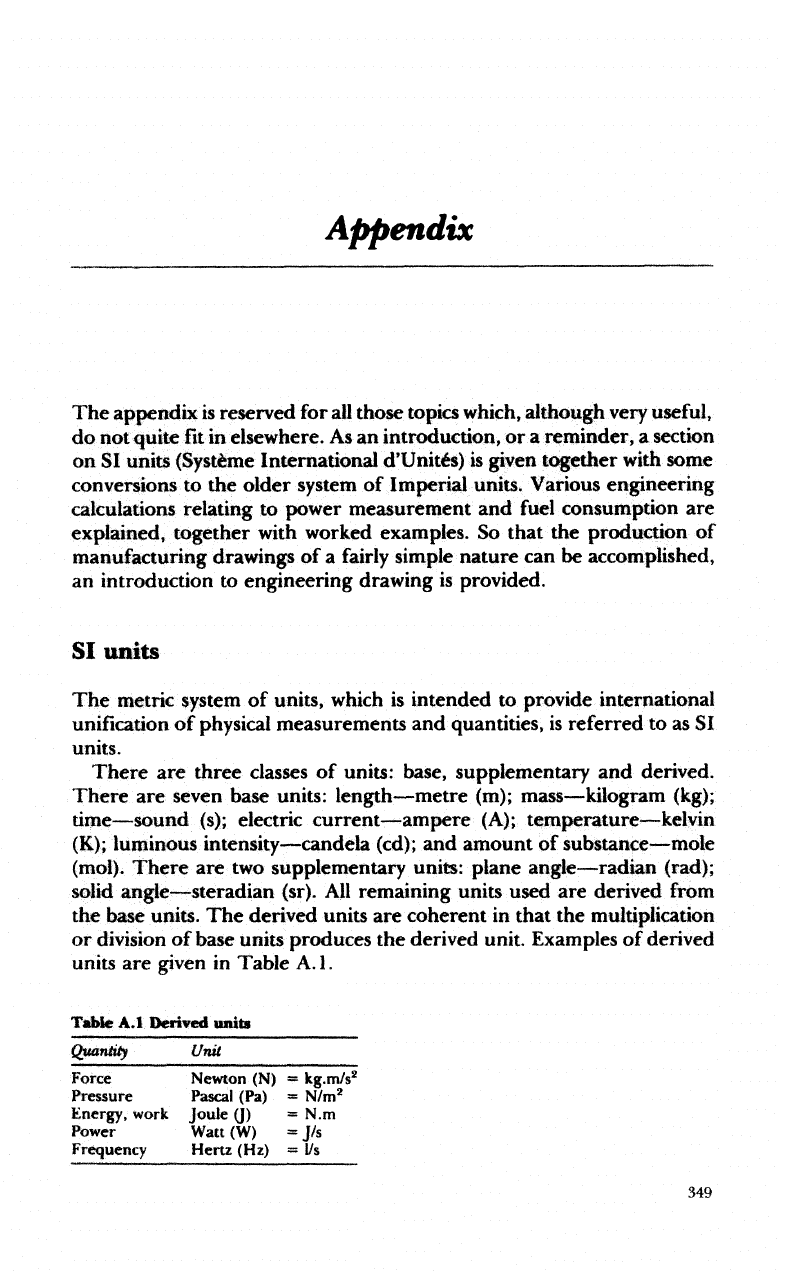
The
appendix
is
reserved
for all
those topics which, although very
useful,
do not
quite
fit in
elsewhere.
As an
introduction,
or a
reminder,
a
section
on SI
units
(Systeme
International
d'Unites)
is
given
together
with
some
conversions
to the
older
system
of
Imperial units. Various engineering
calculations
relating
to
power measurement
and
fuel
consumption
are
explained, together
with
worked examples.
So
that
the
production
of
manufacturing
drawings
of a
fairly
simple nature
can be
accomplished,
an
introduction
to
engineering drawing
is
provided.
SI
units
The
metric system
of
units,
which
is
intended
to
provide international
unification
of
physical measurements
and
quantities,
is
referred
to as SI
units.
There
are
three
classes
of
units: base, supplementary
and
derived.
There
are
seven base units:
length—metre
(m);
mass—kilogram
(kg);
time—sound
(s);
electric
current—ampere
(A);
temperature—keivin
(K);
luminous
intensity—candela
(cd);
and
amount
of
substance—mole
(mol).
There
are two
supplementary units: plane
angle—radian
(rad);
solid
angle—steradian
(sr).
AH
remaining units used
are
derived
from
the
base
units.
The
derived units
are
coherent
in
that
the
multiplication
or
division
of
base units produces
the
derived
unit.
Examples
of
derived
units
are
given
in
Table
A.
1.
Table
A.I
Derived
units
Quantity
Force
Pressure
Energy, work
Power
Frequency
Unit
Newton
(N)
Pascal (Pa)
Joule
(J)
Watt
(W)
Hertz (Hz)
=
kg.m/s
2
-
N/m
2
-
N.m
-J/s
=
l/s
349
Appendix
